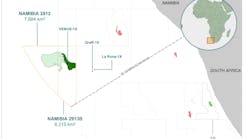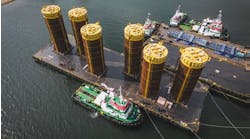Jennifer Hull
Gulf of Mexico Editor
Deeper waters and deep gas will draw exploration dollars into the Gulf of Mex-ico this year, analysts say. Throughout 2002, the majors have been exiting the mature basins in the Gulf and moving to deep and ultra-deepwater, Luiz Rocha, Deloitte & Touche's oil and gas manager, says. The inde-pendents are following behind and filling the niches left behind by the majors while the gov-ernment helps with royalty relief incentives, he adds.
After so many years of continuous growth, activity is going back to basics, Rocha says.
"If you look at the Gulf of Mexico and all around the US, there was a sort of a peak on activity" in terms of drilling rigs and other leading indicators, he said. Now, he added, the industry is readjusting to the basics.
Matt Snyder, senior geologist in Deloitte & Touche's oil and gas group, expects an increase in shelf drilling in the next 6-18 months.
"The deeper gas play is going to become a lot more in focus for the companies," he said.
And the independents will be more visible in that arena as the majors continue their exit from shallow water acreage to deeper prospects.
Royalty relief for deep shelf gas will play a part in the expected rejuvenation of the shelf, Snyder says, though the effects of the relief will likely not be seen for a bit longer. First, he says, companies must study their new holdings before determining where to drill in these five-year leases. But when they're ready, the rigs will be capable and available, Snyder expects.
"You're not going to see that much increase in deepwater drilling," Snyder said, noting that he expects most 2003 work in the deepwater to be of the development variety rather than exploration.
"There's real pressure on the oil and gas companies to extract some sort of shareholder value," Snyder said. "They see the easiest way to do that is to increase production."
A secondary reason he doesn't expect an increase in deepwater exploration is the need for an expanded deepwater infrastructure system in the Gulf. Once in place, he said, the infrastructure will help deliver better economics for deepwater projects.
With deepwater production rates slowly rising, Rocha expects continued development in the deepwater Gulf.
"Companies are trying to focus less on exploration and much more on development," he said. "They are trying to monetize reserves they have in place."
Deloitte & Touche is not the only firm that likes what deep gas could do for the Gulf of Mexico in 2003. PetroSolutions Ltd. President Tom Harris said his consultancy expects continued interest in the deepwater, deep shelf gas, and shallow shelf GoM.
"There's also some interest in looking hard at secondary or tertiary recovery techniques for the shallow shelf," he said.
Drilling, developing fields, pushing water depth limits and reservoir depths, and reducing costs will all remain focal points in the Gulf in 2003, Harris says. One trend he expects to continue is that of the operators pushing the service industry to help reduce costs in bringing marginal fields online.
"I remember way back when, we never thought we'd make money out there," Harris said of the high costs and other potential barriers to entering the high-stakes deepwater. "The industry has risen to the challenge."
As far as drilling levels go, Harris expects 2003 to be similar to 2002. One reason is that companies are taking longer views on their portfolios.
"When you step back from the United States and what's going on there, the Gulf of Mexico is an active area," he said. "It's going to receive continued attention and renewed attention. There will be other companies coming into the Gulf of Mexico from overseas or international, but that's a continuation of what's going on."
Harris cites the large number of producing deepwater fields in addition to the 30 or so deepwater fields sanctioned for development to support his expectation of the extended interest in the Gulf.
"The US Gulf of Mexico is a hotspot offshore," Harris said. "It's an active area, and it's going to remain an active area."
Another bright spot is deep shelf gas. Deep shelf gas fields "are attractive targets," Harris said. The government's addition of royalty relief on the first 20 bcf of gas from below 15,000 ft is only one reason the independents are drilling for the deep gas.
"Are they dropping everything else for it? No. Are they going into it with a balanced look and a cautious eye? Yes," Harris said.
Day rates to stay flat in 1Q
Roger Read, vice president for research at Simmons & Co. International, expects to see improvement in the second quarter and a marked upswing in the Gulf of Mexico in the second half of the year. As of early December, day rates for jackups were trickling downward, he said. Premium jackup day rates were dropping because E&P companies have not been aggressively drilling in the GoM, deep formation drilling has slowed, and Transocean has floated some of its previously stacked low-end jackups to work in the Gulf, he said. This additional supply with generally flat demand, Read said, has led to the dropping day rates for premium jackups.
"We think that pretty well continues into the first quarter," he said, noting it is difficult to draw any positive day rate scenarios for the Gulf in the first quarter.
The GoM jackup market will likely begin stabilizing in 1Q 2003 with improvement during the remainder of the year, he said.
"The start of the year might be a little slow," he said. He doesn't expect a flurry of drilling when the calendar moves out of 2002.
The inquiries that typically indicate potential drilling activity have not arisen, "so it's obvious that we're not going to start in January on some sort of great tear of activity," Read said.
For day rate expectations, the company estimates that the 350-ft jackups will move from the current prices between $30,000/d and $45,000/d to $50,000/d by the end of 2003, assuming 95% utilization for the year. Simmons Co. expects gas prices to average $3.80/MMcf and oil to average $25/bbl for 2003, which could lead to a 10-15% jump in E&P spending, he said.
"That's when we think the market gets better," Read said.
Average utilization rates expected to increase
With the average Baker Hughes GoM offshore rig count for 2002 at 113, Kurt Hallead, RBC Capital Markets managing director, forecasts an average of 120 rigs working in the Gulf in 2003.
"We're going to see the independents shift a lot of their budget money to chase deep gas on the shelf," he said.
Economic incentives for deep gas include a higher production rate and a higher reserve base compared to other pools of gas, he said.
In terms of utilization, Hallead expects 300-ft class rigs to maintain about a 90% utilization rate in 2003, similar to its current level. The 250-ft and lower rigs will likely see a bit of an increase to between 60% and 70% utilization rates.
Hallead attributed the projected marginal increase to Transocean's planned initial public offering for its shallow rig business. These utilization rates are also going to help increase day rates in 2003, he said.
"There's been some volatility with pricing throughout the course of the year," Hallead said.
The day rate averages for 2002 are 250-ft at $23,000/d, 300-ft at $25,000/d, and 350-ft at $28,000/d, while the averages estimated for 2003 are 250-ft at $28,000/d, 300-ft at $31,000/d, and 350-ft at $35,000/d, he said.
"North American E&P spending is going to be a lot more focused in 2003 than it has been in the past, with specific emphasis on the Gulf of Mexico and deep shelf gas," he said.






